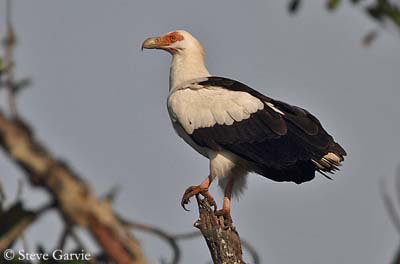
Palm-nut Vulture
Gypohierax angolensis
Accipitriforme Order – Accipitridae Family
BIOMETRICS:
Length: 60 cm
Wingspan: 150 cm
Weight: 1360-1700 g
DESCRIPTION:
Palm-nut Vulture is the only member of the genus Gypohierax, and an Old World Vulture.
Adult has white plumage overall, except the black back, secondaries and primary tips. The short tail is black with white terminal bar, very conspicuous in flight.
Underparts are white with the same black wing pattern than above.
Fr : Palmiste africain
All : Palmgeier
Esp: Buitre Palmero
Ital: Avvoltoio delle palme
Nd: Palmgier
Russe: Пальмовый гриф
Photographer:
Steve Garvie
RAINBIRDER Photo galleries
Text by Nicole Bouglouan
Sources:
HANDBOOK OF THE BIRDS OF THE WORLD Vol 2 by Josep del Hoyo-Andrew Elliot-Jordi Sargatal - Lynx Edicions - ISBN: 8487334156
BIRDS OF THE GAMBIA AND SENEGAL by Clive Barlow and Tim Wacher – Helm Field guides – ISBN: 0713675497
BIRDS OF PREY OF AFRICA AND ITS ISLANDS by Alan and Meg Kemp - Struik Publishers - ISBN: 1770073698
BirdLife International (BirdLife International)
Wikipedia (Wikipedia, The Free Encyclopedia)
Other article: The Old World Vultures

On the white head, we can see a bare orange-red skin around the eyes and the bill.
The fairly long, hooked bill is pale grey with yellowish cere. Eyes are yellow. Legs and feet are pinkish.
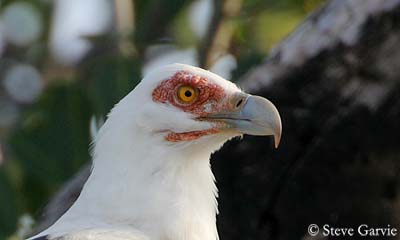
Both sexes are similar, with female slightly larger than male.
Juvenile has brown plumage and yellowish facial skin. Bill is black and eyes are brown.
Subadult has brown plumage on body and wing coverts. Wings and tail patterns are similar to adults. The bare skin of the face is turning orange and the eyes are yellow. The bill is paler.
VOICE: SOUNDS BY XENO-CANTO
Palm-nut Vulture is usually silent as other vultures. But during the courtship and defence displays, it produces some weak growls and high-pitched squeals.
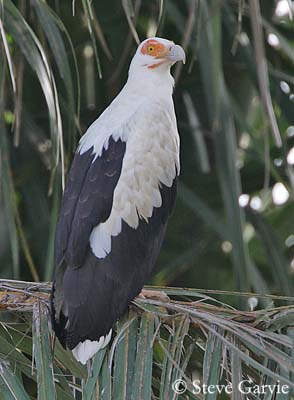
HABITAT:
Palm-nut Vulture frequents the tropical forests’ edges, lakes, estuaries, large rivers and sea shores, all the places where it can find Oil Palms.
It may be found in drier areas if there are Oil and Raphia Palm plantations.
RANGE:
Palm-nut Vulture is sedentary in most of the range, across Africa, South of the Sahara, from the Gambia to Kenya, and southwards to north-eastern South Africa.
BEHAVIOUR:
Palm-nut Vulture unlike most birds of prey, feeds primarily on plant matter such as the fleshy husks of Oil and Raphia Palm fruits. It also takes other fruits and grain, and sometimes small vertebrates and invertebrates such as fish, crabs, amphibians and molluscs.
It is rarely seen at carcasses, but it may eat some disabled medium-sized birds or mammals, or as carrion.
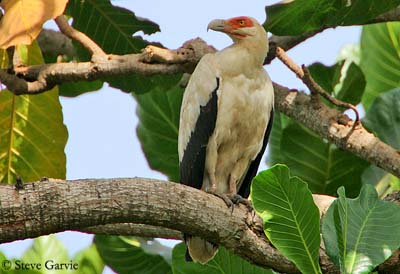
Its favourite food is the nut of Palm, and the Palm-nut Vulture spends most of the time often hanging below the fruit. It pulls off the fruit with the bill and then, it holds it in the feet and rends it.
For other kind of food, it may take fish from the water surface, or collect other food items by paddling around at water edge or walking about on beaches and river banks.
Palm-nut Vultures gather at abundant food sources. They also roost in large trees, sometimes in groups.
When the breeding season starts, both mates fly and soar together, performing beautiful flight displays with rolling and diving. They perform more acrobatic displays than other vultures.
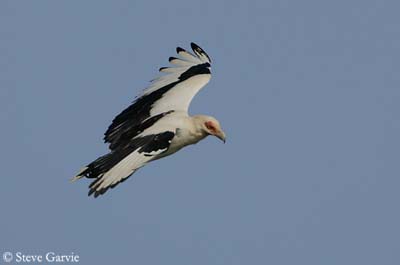
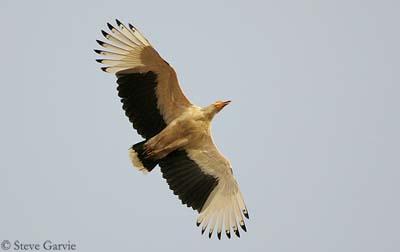
Palm-nut Vulture is sedentary in the areas where palm fruits are abundant. It is also resident along some east African coasts where it can feed on crabs and fish, added to the usual diet.
Non breeding adults and juveniles may disperse to drier areas.
FLIGHT:
Palm-nut Vulture has rounded wings and short tail. It is able to sustain flapping flight with rapid, stiff wing-beats.
It also may be seen soaring with fanned tail, showing the conspicuous wing and tail flight patterns.
Although bulky, it soars during long periods and does not depend on thermal currents. For this reason, Palm-nut Vulture is often active in the early morning.
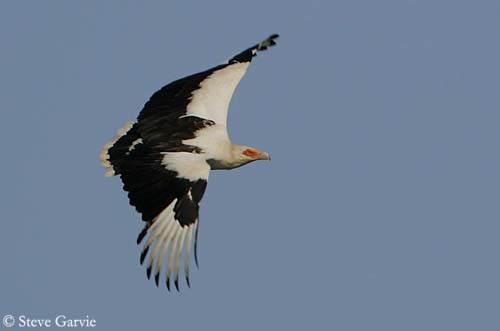
REPRODUCTION:
Breeding season varies according to the range.
Palm-nut Vulture builds a large platform with sticks and branches. The interior is lined with fresh leaves and palm fronds. It is usually situated at top of tall tree, sometimes in open fork, or in palm or euphorbia. Adults often stay in the surrounding of the nest-site all year round.
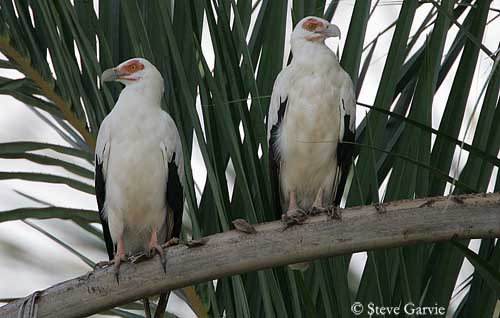
Female lays single white and brown egg. Both parents share the incubation during about six to seven weeks.
The downy chick is brown. It is fed and raised by both adults, and fledges about three months later.
DIET:
Palm-nut Vulture feeds primarily on fruits of Elaeis guineensis and Raphia palms which are a constant base of the diet of this species.
These nuts are rich and oily, but with large kernel and little pulp.
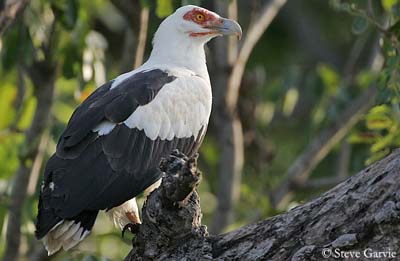
It may take some fish at water surface, and small vertebrates and invertebrates, disabled medium-sized preys and sometimes carrion.
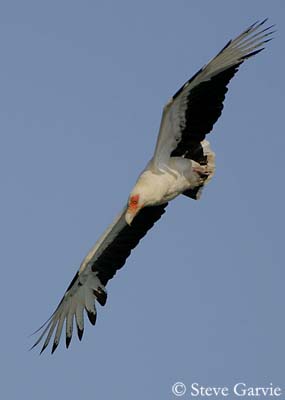
PROTECTION/THREATS/STATUS:
Palm-nut Vulture is common in its range, probably the commonest vulture in many lowlands and forest areas of west and centre Africa.
This species is not threatened at this moment.